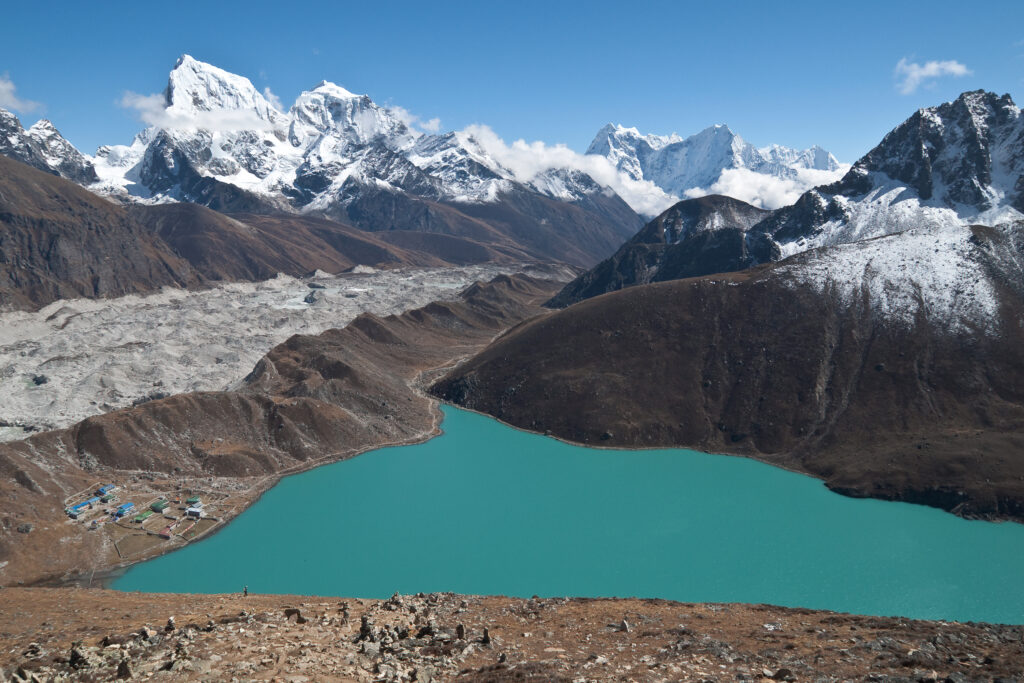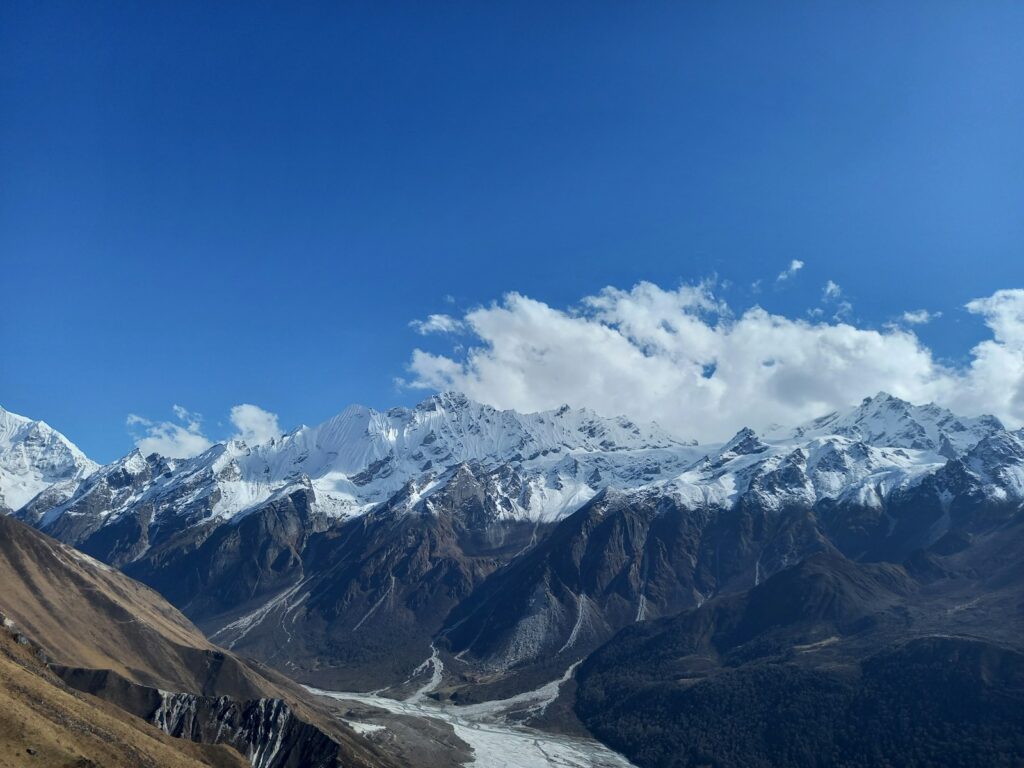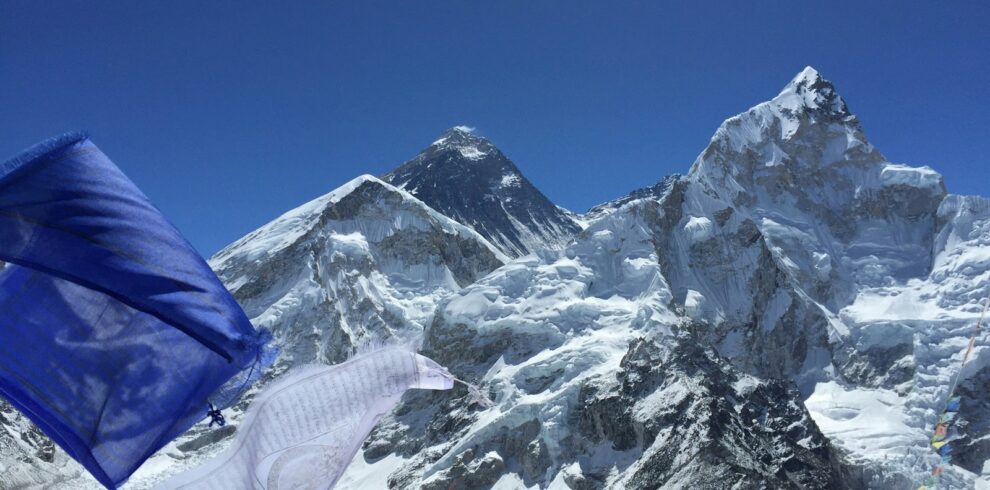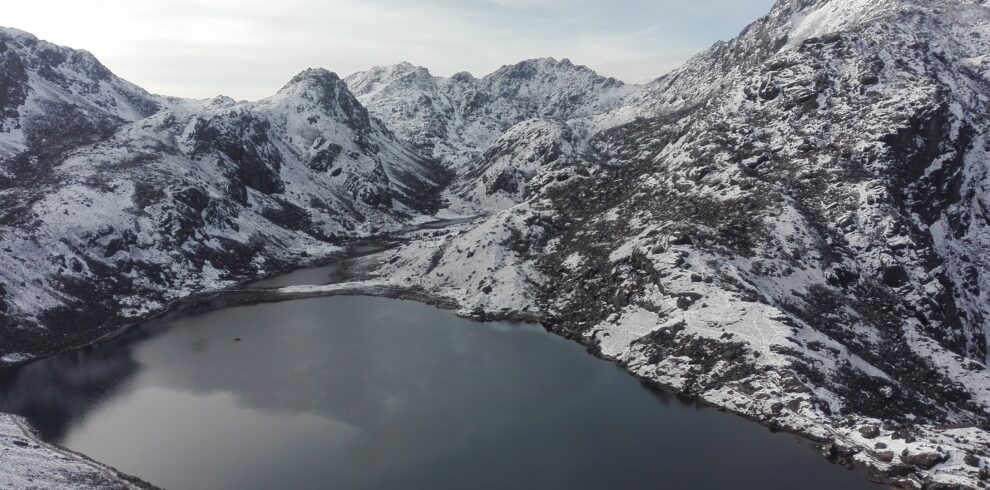Trip Info
-
Nepal
-
Everest Region
-
Trekking
-
14 Days
-
Spring - Autumn
-
Moderate
-
5357 Meters
-
1 - 32 People
-
30 Days Before Start
Overview
The Gokyo Lakes Trek is a stunning alternative to the classic Everest Base Camp route, offering a quieter and equally breathtaking experience in the Everest region. This trek follows the traditional Everest trail up to Namche Bazaar before branching off into the peaceful and less-traveled Gokyo Valley, home to a series of six turquoise glacial lakes that are considered some of the most beautiful in the world. Surrounded by snow-capped peaks and serene alpine landscapes, the Gokyo Lakes provide a surreal setting that captures the pristine essence of the Himalayas.
Along the way, you’ll pass through charming Sherpa villages, lush forests, and rugged terrain, with ample opportunities to learn about Sherpa culture and lifestyle. A highlight of the trek is the climb to Gokyo Ri (5,357m), which offers one of the best panoramic views in the entire region, including majestic sights of Mount Everest, Lhotse, Makalu, and Cho Oyu. The Gokyo Lakes Trek is perfect for those seeking a less crowded, culturally immersive, and visually stunning journey in the Everest region—without the need to visit Everest Base Camp or cross any technical high passes.
Trip Highlights
- Scenic flight to and from Lukla.
- Experiencing life as the “mountain people” live, in the heart of Himalaya.
- Visiting Tengboche Monastery.
- Stunning views of Gokyo Valley and Gokyo Lakes
Itinerary
This is your first day in Kathmandu. Our airport representative will pick you up from the airport and transfer you to designated hotel in the city. Depending on your flight times you have the day free for exploration or visit the local streets of Kathmandu. In the evening you will be meeting with your guide and have introduction with him. The evening is free. Overnight at hotel
Transfer to domestic airport and 30-minutes flight to Lukla. The trek begins gently up by the river side, along excellent paved footpaths, passing a multitude of teahouses and scattered green conifers. Phakding at 2,610 m, is a pretty village comprising approximately 35 houses. It is roughly a 3/4-hour walk from Lukla and is located at both sides of Dudh Koshi River. Overnight at guesthouse.
The day will begin with breakfast and walk to Monjo, another beautiful Sherpa settlement of the trek; official entry into the Sagarmatha National Park where you will have to show your permits, at the check point in Monjo.The walk to Namche Bazaar involves a tough uphill climb of about 590m, taking approximately 5/6-hours,As gateway to the Khumbu region, Namche Bazaar, at an altitude of 3440meters, is famous for its many bakeries and local market which takes place each Saturday. Built on a steep mountain bowl with excellent views of high Himalaya on the side, the town has restaurants, shops, banks and currency exchange. There are also availability of cyber cafes and pool halls. Overnight at guesthouse.
It is important to walk to higher altitudes while you stay two days in Namche bazaar. There are options here either to trek to Khumjung where you can visit the local area and to Thame village of Sherpa Everest expediters and syangboche, above the airstrip is the Everest view hotel, which was set up by the Japanese to bring affluent tourists into the region for a prime view of Everest. The scheme was brought down by the fact that the hotel was at nearly 4000m and many suffer from altitude sickness. Overnight at guesthouse.
Today the trail at first slightly climb up for a while up to the Chor camp at Namche Bazzar then continue easy level walk to kyangjuma 3550m. Along the way from chor camp at Namche bazaar to kyangjuma you may enjoy incredible view of Mt. Everest (8848), Lhotse (8516m), Lhotse shar (8382m), Nuptse (7879m), peak- 38(7591m), Ama dablam (6856m), Thamserku (6623m), Kangtega (6783m), Kusum kangaru (6367), Cholaste (6335m), Tabuche peak (6495m), Khumbi La (5765m) and Kwangde Ri (6011m). From kyangjuma the trail follows for a while easy level walk through Rhododendron forest to sanasa .There is three way directions from where one way right hand side leads to the direct Everest base camp trek and another way up ward left hand side leads to the Gokyo valley trek. From here the trail steep climb up approximately one and half hour to reach at Mongla danda (3978m) where there are a few teahouse and a chorten so you may rest here for a while and enjoy magnificent view of Mt. Ama dablam including many mountains. The trail from Mongla danda descends in steep bends trail to Phortse thanga (3680m). From Phortse thanga you will meet two trails one higher route left hand side lead to Gokyo valley trek and lower trail right hand side lead to Phortse village. From after Phortse Thanga the trail climbs steeply through and junipers forests then after small part level walks before to reach at Dole (4090m).Overnight at guesthouse.
The trek from Dole to Machhermo you will climb gradually along the side of the valley, where the small and thorny bushes give way to scrub juniper as the altitude increases. The trail passes many summer settlements, which are used when yaks are taken to these pastures to graze in the summer months. Ahead of you are excellent views of Cho Oyu (8201m) while back down the valley are the peaks of Kantega (6783m) and Thamserku (6623m). You are walking through Lhabarma (4330m), Luza (4340m) and finally reach at Machhermo (4410m). Overnight at guesthouse.
Today trek from Machhermo to Gokyo the trail climbs a ridge for an excellent view both down valley to Kangtega and up towards to Cho-Oyu (8201m). Beyond the ridge, the valley widens as the trail passes through Pangka at 4390m then descends to the river bank before beginning the climb onto the terminal moraine of the Ngozumpa glacier. It is a steep climb up the moraine, switch backing alongside the stream to the first small lake Longponga (4650m) where a family of Brahmin ducks has resided for many years. After first lake the trail now becomes almost level as it follows the valley past a second lake known as Taujung (4710m) and continue trek to Gokyo Lake (4750m). Overnight at guesthouse.
Early in the morning we have a steep climb up to the top of Gokyo RI (5357m). There are stunning views of the Gokyo valley, the massive Ngozumpa Glacier and an incredible panoramic view of the whole Khumbu mountains range, such giants as Mt. Cho Oyu (8201m) Mt. Everest (8848), Lhotse (8516m), Nuptse (7879m), Makalu (8481m), Cholaste (6335m), Tabuche peak (6495m) and Gychung Kang (7922m). After enjoy the beautiful views at Gokyo Ri then return to Gokyo (4750m) overnight at guesthouse.
Begin the day with an early morning hike to Gokyo Ri (5,357m) for one of the best panoramic views in the Everest region, including Mount Everest, Lhotse, Makalu, and the stunning Gokyo Lakes below. After soaking in the sunrise and capturing breathtaking photos, descend back to Gokyo for breakfast. From there, retrace your steps down the valley, passing through scenic alpine terrain and small Sherpa settlements. The trail gradually descends, offering a more relaxed walk to Machhermo. This day combines a rewarding viewpoint with a peaceful return through the heart of the Gokyo Valley.
Trek from Machhermo to Khumjung (3,790m) takes about 5 to 6 hours, descending through beautiful alpine landscapes and traditional Sherpa villages. Along the way, enjoy views of Ama Dablam and Thamserku while passing through forests and river valleys. Khumjung is a charming village known for the Hillary School and Khumjung Monastery, offering a rich glimpse into Sherpa culture.
Today’s trek from Khumjung (3,790m) to Phakding (2,610m) takes about 5 to 6 hours, following a mostly downhill route through the Dudh Koshi Valley. The trail passes through Namche Bazaar, where you can take a short break before continuing the descent via suspension bridges, pine forests, and small Sherpa villages. It’s a relaxing day with gradual terrain, allowing you to enjoy the mountain views and reflect on your journey. Phakding, nestled along the riverside, offers a peaceful stop before your final trek to Lukla.
The final day of the trek takes you from Phakding (2,610m) back to Lukla (2,860m), a journey of about 3 to 4 hours. The trail gradually ascends through forests, across suspension bridges, and past traditional Sherpa villages like Ghat and Chheplung. Though short, the walk is meaningful as you reflect on your Himalayan adventure. Arriving in Lukla marks the end of your trek, where you can relax and celebrate your achievements before the flight back to Kathmandu.
In the morning, we take the tiny aircraft to flight from Lukla to Kathmandu which is very interesting scenery flight journey on the earth. After arrival in Kathmandu airport we drive you to hotel. Overnight at hotel.
Today our airport representative will come to meet you at the hotel to escort you to Kathmandu International Airport for your final departure.
Includes
Cost Includes
- Accommodation in three star category hotel as per the itinerary in kathmandu
- Three meals a day (Breakfast, Lunch, Dinner) with hot beverage and snacks whilst on trekking.
- Cozy guesthouse accommodation whilst on trekking as per the itinerary.
- All necessary government and local permits, National Park entry fees
- TIMS registration card
- An experienced fluent English speaking guide, licensed by ministry of Culture, Tourism & Civil Aviation.
- Highly experienced well equipped trekking support staff (porter).
- Staff food, accommodation, clothing, salary & insurance.
- All necessary ground transportation as per the itinerary
- Airport transfers during the whole trip as per the itinerary
- Farewell dinner in Kathmandu at typical Nepali restaurant.
Cost Excludes
- International Airfare, visa fees and re-entry visa fees if applicable
- Meals at Kathmandu and any other cities except mentioned.
- Hotel accommodation in kathmandu.
- Personal nature expenses like bar bills, beverage bills, telephone bills, laundry etc.
- Your Travel Insurance and rescue evacuation, medical costs.
- Gratitude (tip) for staff
FAQs
Yes, most treks in Nepal require one or more permits. The most common are the TIMS (Trekkers’ Information Management System) card and area-specific permits like the Annapurna Conservation Area Permit (ACAP) or Sagarmatha National Park Permit. Restricted areas such as Upper Mustang or Manaslu require special permits and must be arranged through registered trekking agencies. Carrying the correct permits is essential, as checkpoints are common along trails.
The ideal trekking seasons are spring (March to May) and autumn (September to November). These months offer clear skies, mild temperatures, and breathtaking mountain views. Spring is known for blooming rhododendrons, while autumn offers the best overall weather conditions. Monsoon (June to August) brings heavy rains, and winter (December to February) can be extremely cold and snowy at higher altitudes.
Fitness requirements vary depending on the trek, but a good baseline of cardiovascular health and endurance is helpful. Treks range from easy, low-altitude hikes like Ghorepani Poon Hill, to challenging high-altitude circuits like Everest Base Camp or Manaslu Circuit. Regular walking, stair climbing, or hiking in advance can prepare you well. Mental stamina is equally important, especially on longer or more remote trails.
Yes, altitude sickness, or Acute Mountain Sickness (AMS), can affect anyone above 2,500 meters, regardless of fitness or experience. Common symptoms include headache, nausea, dizziness, and shortness of breath. To reduce the risk, it’s essential to acclimatize properly, ascend gradually, stay hydrated, and avoid alcohol. In serious cases, descending is the only effective treatment, and travel insurance should cover emergency evacuation if needed.
Independent trekking is allowed in many areas like Annapurna, Everest, and Langtang. However, restricted areas such as Upper Mustang, Manaslu, and Dolpo require you to trek with a registered guide and at least two trekkers. Even where not mandatory, many trekkers choose to hire a guide for navigation and cultural insight or a porter to reduce physical strain. Going with a guide also adds a layer of safety and local support.
Most popular treks in Nepal offer teahouse accommodation, which are small lodges run by local families. These lodges typically provide basic rooms with shared bathrooms, local meals like dal bhat, and sometimes limited electricity or Wi-Fi. In more remote or less-developed areas, accommodation may be more rustic or require camping arrangements. It’s advisable to carry a sleeping bag for warmth and hygiene, especially in higher elevations.
Packing smart is key, as you’ll want to balance essentials with minimal weight. Core items include layers of clothing, a warm down jacket, sturdy trekking boots, a sleeping bag, headlamp, and first-aid kit. Don’t forget water purification tablets, snacks, sunscreen, and trekking poles if needed. Depending on the route and altitude, gear requirements may vary, and renting equipment in Kathmandu or Pokhara is also an option.
Yes, travel insurance is strongly recommended for all trekkers in Nepal. Your policy should specifically cover trekking at high altitudes (up to 6,000 meters or more) and include emergency helicopter evacuation. Medical care in remote areas is limited, and evacuation can be very expensive without insurance. It’s also helpful if your insurance covers trip cancellations, lost luggage, and other travel mishaps.
In more developed trekking regions like Everest and Annapurna, some villages have ATMs and paid Wi-Fi, but these services can be unreliable. In remote areas, there may be no access to banks or internet, so it’s best to carry enough cash (Nepali rupees) for your entire trek. Lodges often charge extra for device charging or internet usage. Trekking unplugged can be part of the adventure, so plan accordingly.
Yes, Nepal is generally considered a safe destination for solo female travelers, especially on well-trodden routes. Many women trek alone every year without issues, but taking basic precautions, such as informing someone of your plans and staying in reputable lodges, is wise. Hiring a female guide or joining a group can enhance safety and add cultural depth. Nepalese people are friendly and hospitable, but like anywhere, it’s important to stay aware of your surroundings.









